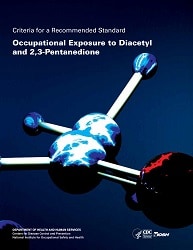Criteria for a Recommended Standard: Occupational Exposure to Diacetyl and 2,3-Pentanedione
October 2016
DHHS (NIOSH) Publication Number 2016-111

Diacetyl and its substitute, 2,3-pentanedione, are widely used as flavoring compounds. The National Institute for Occupational Safety and Health (NIOSH) objective in establishing recommended exposure limits (RELs) for diacetyl and 2,3-pentanedione is to reduce the risk of respiratory impairment (decreased lung function) and the severe irreversible lung disease obliterative bronchiolitis associated with occupational exposure.
In this Criteria Document, NIOSH reviews the scientific literature concerning potential health effects, toxicology, and risk assessment pertaining to diacetyl and 2,3-pentanedione. Recommendations are provided on engineering controls, work practices, and personal protective equipment to prevent and control workplace exposures to diacetyl and 2,3-pentanedione.
This Criteria Document is contained in PDF files, for ease of handling. The following table of contents allows you to open or download individual sections or the entire Criteria Document:
- Entire Document [PDF – 37 MB]
- Executive Summary [PDF – 49 KB]
- Executive Summary and Front Pages [PDF – 27 MB]
- Chapter 1 – Introduction [PDF – 176 KB]
- Chapter 2 – Assessing Occupational Exposure in Employees [PDF – 235 KB]
- Chapter 3 – Effects of Exposure in Employees [PDF – 445 KB]
- Chapter 4 – Toxicology of Diacetyl and 2,3-Pentanedione [PDF – 262 KB]
- Chapter 5 – Quantitative Risk Assessment Based on Employee Data [PDF – 530 KB]
- Chapter 6 – Quantitative Risk Assessment Based on Animal Data [PDF – 486 KB]
- Chapter 7 – Basis of the Recommended Standards for Diacetyl and 2,3-Pentanedione [PDF – 119 KB]
- Chapter 8 – Hazard Prevention and Control of Exposures to Diacetyl and 2,3-Pentanedione [PDF – 2 MB]
- Chapter 9 – Medical Monitoring and Surveillance of Exposed Employees [PDF – 256 KB]
- Chapter 10 – Exposure Monitoring in Occupational Safety and Health Programs [PDF – 103 KB]
- Chapter 11 – Research Needs [PDF – 57 KB]
- Appendices
